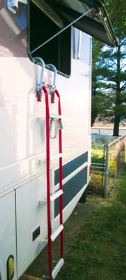Make sure you can evacuate the motorhome safely in the event of an emergency.
By Ed Hopkins, F242191
February 2013
Every motorhome is built with an emergency exit such as a window or door at the opposite end of the vehicle’s normal entry. This is required in the event that an emergency such as a fire exists in the area of the normal entry. In many cases, this opening is located high above the ground, making it a potentially dangerous and scary exit point. To reduce the risk of injury while trying to evacuate the motorhome via the emergency exit, I suggest you invest in an escape ladder.
An escape ladder should be light, flexible, strong, sturdy, and simple to use for all sizes of people. The top rung of the ladder must be at a reasonable distance from the bottom of the exit window to allow occupants to get a foot set comfortably and safely on the rung and get the second foot and leg situated so that egress from the RV can be accomplished.
Several companies offer escape ladders for residential use. However, these ladders are designed and built for windowsills that you would find in a house or apartment. They have large hooks that wrap around the windowsill and brace against the inner wall. While these work well in a house, the hooks are far too large for an RV windowsill that may be only a few inches deep.
I purchased a Kidde model KL-2S 13-foot escape ladder that was designed to be used to exit a second-story window of a home or business. First Alert also manufactures a similar ladder. These ladders can be purchased from home-improvement stores for approximately $30.
What I found when I hung the ladder out of my motorhome window was that it was not very stable and lacked sideways support. While I was able to exit the motorhome using the ladder, I did not feel comfortable. Others may be okay using the ladder as is, but I didn’t feel it was completely safe. Therefore, I came up with a modification to the hook portion of the ladder so it would attach more snugly to the windowsill.
The KL-2S has a two-piece metal loop that wraps around the windowsill and braces against the interior wall. My idea was to remove one of the pieces so just the hook portion would hang on the motorhome’s windowsill.
The tools required to modify the ladder included a 5/16-inch wrench, a drill and a 7/32-inch drill bit, a knife or scissors, and a measuring device.
Here are the steps for the modification project.
1. Loosen and remove the nuts and washers from the U-bolts that hold the straps to the attachment hooks. Pull the U-bolts out of the holes and return the washers and nuts to the bolts; this will prevent you from losing this hardware, since you will need it later.
2. Once you have the hook portion removed from the ladder straps, use the drill with a 7/32-inch drill bit to drill out the concave ends of the rivets that hold the two pieces together. The rivets can then be pushed out and the bottom and top parts separated. You will keep the top portion.
3. Drill a set of 7/32-inch-diameter holes spaced 1 3/16 inches apart in each of the attachment hooks (as shown in the pictures). These holes will be used to reattach the step straps.
4. Reattach the step straps to the attachment hooks using the U-bolts. Be sure that the hook arms and the step standoffs are oriented in the same direction. Tighten the nuts so that they are fully on the U-bolts.
5. Open the emergency exit and place a prop between the window and sill to hold it open. (I use a 24-inch-long venetian blind turner rod for this purpose. It should be stored in the same vicinity as the ladder to ensure that it will be available if needed for an emergency escape.) While setting up the RV escape ladder and practicing egress, place a blanket or towel over the window sill and down the outside of the RV to prevent damage to your motorhome.
6. Hang the RV escape ladder outside of the motorhome by placing the attachment hooks over the windowsill of the emergency exit, and allow the rest of the ladder to unroll down the side of the motorhome. You should now be able to exit the RV and climb down to the ground safely.
7. If you are happy with the results, determine how long you want the ladder to be and cut off the straps on each side just below the bottom step. You probably will want to attach some felt or rubber padding on the step standoff pads where they contact the side of the motorhome. You also should purchase several lengths of 1.5-inch-inside-diameter rubber tubing and slide it up the attachment hook below the strap where the ladder touches the outside of the RV to prevent it from marking the motorhome’s exterior finish.
I hope that you will never have to use an RV escape ladder, but in the event it is needed, make sure to store it close to the emergency exit window. Also, practice using it often to be sure that your occupants are familiar with the location of the exit, that the window opens easily, and that all occupants can safely exit.

